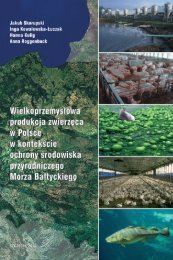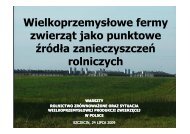best available technologies for manure treatment - Baltic Green Belt
best available technologies for manure treatment - Baltic Green Belt
best available technologies for manure treatment - Baltic Green Belt
Create successful ePaper yourself
Turn your PDF publications into a flip-book with our unique Google optimized e-Paper software.
Best Available Technologies <strong>for</strong> <strong>manure</strong> <strong>treatment</strong> baltic sea 2020<br />
Best Available Technologies <strong>for</strong> <strong>manure</strong> <strong>treatment</strong> baltic sea 2020<br />
ANNEX E: TABLES WITH SHORT DESPRIPTION OF LIVESTOCK MANURE TREATMENT TECHNOLOGIES<br />
Best Available Techniques <strong>for</strong> <strong>manure</strong> <strong>treatment</strong> - <strong>for</strong> intensive rearing of pigs in <strong>Baltic</strong> Sea Region EU Member States Technical Report "Best Practice Manure Handling, Phase 2"<br />
Ref No. 57 Nitrification-denitrification<br />
Brief description<br />
The nitrification-denitrification process converts the N in the slurry to free N, N<br />
2<br />
, a process that is commonly used in waste water<br />
<strong>treatment</strong> facilities. Biological conversion of ammonia to N gas is a two step process. Ammonia must first be oxidized to nitrate; nitrate<br />
is then reduced to N gas. These react ions require different environments and involve two tanks, an anoxic tank and an anaerobic<br />
digestion tank. The first step in the process, conversion of ammonia to nitrite and then to nitrate, is called nitrification (NH3 NO2 NO3).<br />
The process is summarized in the following equations:<br />
-<br />
NH<br />
4<br />
+ 3/2 O<br />
2<br />
NO<br />
2<br />
+ 2H+ + H<br />
2<br />
O<br />
-<br />
-<br />
NO<br />
2<br />
+ 1/2 O NO<br />
3<br />
It is important to note that this process requires and consumes oxygen, and thus contributes to the BOD (biochemical oxygen demand).<br />
The process is mediated by the bacteria Nitrosomonas and Nitrobacter, which require an aerobic (presence of oxygen) environment <strong>for</strong><br />
growth and metabolism of N. Thus, the nitrification process must proceed under aerobic conditions. The second step of the process, the<br />
conversion of nitrate to N gas, is referred to as denitrification. This process can be summarized as:<br />
-<br />
NO<br />
3<br />
+ 5/6 CH<br />
3<br />
OH 1/2 N<br />
2<br />
+ 5/6 CO<br />
2<br />
+ 7/6 H<br />
2<br />
O + OH -<br />
Description of the effect on<br />
leaching (positive or negative) of<br />
N and P<br />
See the description <strong>for</strong><br />
composting, technology<br />
references number 41 and 41A.<br />
This process is also mediated by bacteria. For the reduction of nitrate to N gas to occur, the dissolved oxygen level must be at or near<br />
zero; the denitrification process must proceed under anaerobic conditions. The bacteria also require a carbon food source <strong>for</strong> energy<br />
and conversion of N. The bacteria metabolize the carbonaceous material or BOD in the wastewater as this food source, metabolizing it<br />
to carbon dioxide. This in turn reduces the BOD of the sewage, which is desirable. However, if the sewage is already low in BOD, the<br />
carbon food source will be insufficient <strong>for</strong> bacterial growth and denitrification will not proceed efficiently. In the aerobic digestion tank<br />
the conversion of ammonia to nitrate and nitrite takes place. In the anoxic tank, microorganisms use the free oxygen in nitrate<br />
compound as a source of energy. The process produces more bacteria and removes N from the slurry by converting it into free N gas,<br />
which is released into the air. The system is build so that oxygen is provided to the slurry by way of tiny aerating bubbles provided by<br />
diffusers.<br />
Innovation stage<br />
Investment price, <br />
Basic Variable<br />
Operational costs,<br />
per tonnes<br />
per kg saved N<br />
or P leaching<br />
Complexity of<br />
implementation<br />
Research<br />
Pilot<br />
Practice <br />
Major references<br />
No data No data<br />
Condition <strong>for</strong><br />
leaching reduction<br />
effect<br />
CBMI, 2009 Scenarios II - V<br />
Prices Low<br />
Effect on leaching High<br />
No data, however a Spanish plant visited by CBMI in June<br />
2009 used 15-20 kWh per ton, alone <strong>for</strong> electricity, but<br />
including separation and composting operations.<br />
Certainty of in<strong>for</strong>mation<br />
Depends on the<br />
situation of the<br />
individual farm.<br />
High – shall be implemented<br />
as a community plant.<br />
76<br />
Side 78<br />
76








